Kuldip Dhiman
Harappan Technology and its Legacy
By D. P. Agrawal.
Rupa & Co. in Association with Infinity Foundation.
Pages 332. Price not mentioned.
WHAT is now known as the Indus Valley Civilisation or Harappan Civilisation was discovered accidentally when a railway line was being laid down in the 1920s. Initially, archaeological sites were found in the twin towns of Mohenjodaro and Harappa, now in Pakistan, but with the passage of time, more and more sites have been found in the north of the Indian subcontinent. It was Sir John Hubert Marshall, the then director-general of the Archaeological Survey of India who carried out initial excavations of the sites. Western historians until then had thought that India's historical past was not more than 3,000 years old, but these excavations pushed the timeline by at least 2,000 years back, if not more.
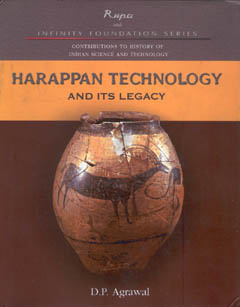 In the present volume, Harappan Technology and its Legacy, D. P. Agrawal focuses on Harappan technological achievements, although he covers other aspects also. This is quite an exhaustive book that covers ecology, technology, architecture, arts, crafts, transportation, stone cutting art, ceramics, metallurgy, pyrotechnology, animal husbandry and agriculture. The author is an expert in the subject, and has worked with the Archaeological Survey of India, Tata Institute of Fundamental Research, and Physical Research Laboratory. He writes in a direct matter-of-fact style, and packs his thesis with hard facts.
In the present volume, Harappan Technology and its Legacy, D. P. Agrawal focuses on Harappan technological achievements, although he covers other aspects also. This is quite an exhaustive book that covers ecology, technology, architecture, arts, crafts, transportation, stone cutting art, ceramics, metallurgy, pyrotechnology, animal husbandry and agriculture. The author is an expert in the subject, and has worked with the Archaeological Survey of India, Tata Institute of Fundamental Research, and Physical Research Laboratory. He writes in a direct matter-of-fact style, and packs his thesis with hard facts.
The first thing that strikes us is the amazing care in town planning that we see in these sites. Major towns could accommodate more than 50,000 people, and the engineers and architects had to be really competent in order do design such settlements. A standard grid was followed in the design of these towns. The engineers of the time made sure to construct reservoirs for drinking water, and also made sewage lines and storm water drains. The Harappan engineering prowess is most clearly revealed in the hydraulic structures. Then we have the Great Bath, which is an example a perfect leak-proof structure.
In the past 90 years, many other sites have been discovered, and with every find, archaeologists and historians have come across amazing all round achievements of the civilisation.
Agrawal shows that when it came to scientific instruments, the Harappans contributed the true saw, needles (with holes at the pointed end), hollow drills, and so on.
"The Harappan arts and crafts," writes Agrawal, "present a bewildering array of forms, techniques, and usage of raw materials. They had a highly developed lapidary industry that could work on hard stones like agate and chalcedony, and soft stones like steatite. They could produce intricate designs by alkali etching of carnelian beads, which were probably meant for export to Mesopotamia."
Another striking feature of the civilisation was standardisation of industrial norms. The Harappans had developed a binary metrological system for measuring weights, and used a unit of 17mm for linear measurements. The bricks used in construction of buildings were of standard size—in fact, all things were standardised.
The Harappans used locally available raw materials for manufacturing crafts such as woodworking, basket making, simple weaving, terracotta pottery, and so on, although they had to import raw materials for stone-shaping for domestic purposes, and chipped stone tool-making. There was a third category crafts using local materials, complex technologies, and intricate production processes such as in stoneware bangle manufacture, elaborately painted pottery, complex weaving and carpet making, ceramics, and metallurgy. They possessed the knowledge of smelting even sulphide ores and produced bronze in complicated shapes.
The Harappans were also good at the arts and this can be seen from the surviving sculptures such as the Red Torso, the Dancing Girl, and the famous Priest King. The sculptors not only were good at human figures, but also at sculpting animals. And then, of course, we have a large collection of ceramics, pots, bowls, pans, etc.
Obviously, a civilisation that had achieved such scientific, technological and artistic heights could not have done so without having a solid agricultural base. At Kalibangan, we can still see plough marks in a field, and a terracotta model of a plough from Banawali is very elegantly designed.
One thing that sets the Harappan civilisation apart is its concern with the ordinary masses. While all the great cities of the world built great palaces and monuments which were largely for the benefit of the rich, the Harappans built structures which were for the masses like the Great Bath and the Granary. They did not show much interest in conquering; they were more interested in creating.
The book has dozens of colour photographs, maps, diagrams and sketches that beautifully illustrate the text. There is an amazing array of new artefacts that makes this volume all the more interesting.
http://www.tribuneindia.com/2009/20091213/spectrum/book2.htm
|
|
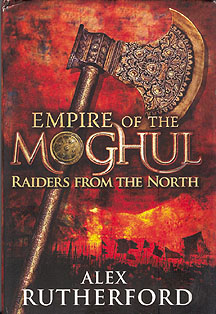 WHEN Babur was barely 12, his father died in a freak accident. Hardly had Babur got over the shock, he had to prepare himself to take over the reigns of Ferghana or else he would be dethroned by his uncles or cousins. Just retaining Ferghana would not be enough, though. His father had told him on several occasions: "We owe Timur a debt. He was a great man, my son. His blood is your blood. Never forget it. Be like him, if you can. Live up to your destiny and let it be greater than mine."
WHEN Babur was barely 12, his father died in a freak accident. Hardly had Babur got over the shock, he had to prepare himself to take over the reigns of Ferghana or else he would be dethroned by his uncles or cousins. Just retaining Ferghana would not be enough, though. His father had told him on several occasions: "We owe Timur a debt. He was a great man, my son. His blood is your blood. Never forget it. Be like him, if you can. Live up to your destiny and let it be greater than mine." With the rise of modern scientific thinking, the last two causes are no longer considered because they would suggest that the world was created by a supreme being. This is not acceptable to modern materialistic science. As scientific thinking began to hold the imagination of thinkers, Friedrich Nietzsche made his bold proclamation a century ago: "God is dead".
With the rise of modern scientific thinking, the last two causes are no longer considered because they would suggest that the world was created by a supreme being. This is not acceptable to modern materialistic science. As scientific thinking began to hold the imagination of thinkers, Friedrich Nietzsche made his bold proclamation a century ago: "God is dead".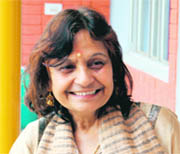



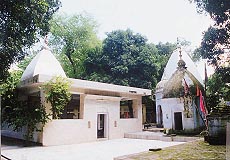
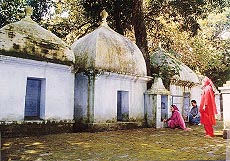

 After the war, Baba wanted to retire to the hills in order to pursue his spiritual goals. While he bathed in the cool waters of one of the valleys, he saw the images of the 10 Gurus. Thus he decided to name it the Darshani Khud and the waters of this khud came to be called Dhauli Dhar or Charanganga.
After the war, Baba wanted to retire to the hills in order to pursue his spiritual goals. While he bathed in the cool waters of one of the valleys, he saw the images of the 10 Gurus. Thus he decided to name it the Darshani Khud and the waters of this khud came to be called Dhauli Dhar or Charanganga. 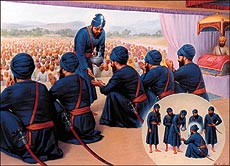 As the farmers waited with bated breath, Shri Guru Gobind Singh ji, the Tenth Guru, appeared holding a naked sword in his hand. He raised his sword and demanded a head from one of his followers. A hush fell over the gathering. No one demurred. The Guru repeated his words. On hearing his demand for the third time, one Daya Ram of Lahore stepped forward and said: "My head is at your service, my Lord", The Guru took the disciple into a nearby tent and soon returned. His sword was now dripping with blood. He raised his authoritative voice and demanded yet another head. Far from being daunted by the thought of death, another disciple, Dharam Das of Delhi, volunteered to sacrifice himself for his Guru. In the events that followed Guru Gobind Singh made three more such calls and consequently Mohkam Chand of Dwarka, Himmat of Jagannath, and Sahib Chand of Bidar came forward and offered their heads.
As the farmers waited with bated breath, Shri Guru Gobind Singh ji, the Tenth Guru, appeared holding a naked sword in his hand. He raised his sword and demanded a head from one of his followers. A hush fell over the gathering. No one demurred. The Guru repeated his words. On hearing his demand for the third time, one Daya Ram of Lahore stepped forward and said: "My head is at your service, my Lord", The Guru took the disciple into a nearby tent and soon returned. His sword was now dripping with blood. He raised his authoritative voice and demanded yet another head. Far from being daunted by the thought of death, another disciple, Dharam Das of Delhi, volunteered to sacrifice himself for his Guru. In the events that followed Guru Gobind Singh made three more such calls and consequently Mohkam Chand of Dwarka, Himmat of Jagannath, and Sahib Chand of Bidar came forward and offered their heads. Earlier, it was a custom to drink the water with which the Gurus washed their feet, but as Guru Gobind Singh wanted to instil martial spirit in his followers, and thus change them from Sikhs to Singhs (lions), he proposed to baptise them by water stirred with a khanda (sword). To strike a blow against the class-ridden society, he urged all his followers to attach 'Singh' to their first names irrespective of their caste or creed. He also asked them to always have on their person Kesh, Kangha, Karha, Kaccha and Kirpan (long hair, a comb, a steel bracelet, a vest, and sword). His followers were to celebrate Holi by conducting martial arts, sport, military parades and mock battles. He later baptised about 20,000 disciples and named the place Shri Anandpur Sahib, the city of bliss.
Earlier, it was a custom to drink the water with which the Gurus washed their feet, but as Guru Gobind Singh wanted to instil martial spirit in his followers, and thus change them from Sikhs to Singhs (lions), he proposed to baptise them by water stirred with a khanda (sword). To strike a blow against the class-ridden society, he urged all his followers to attach 'Singh' to their first names irrespective of their caste or creed. He also asked them to always have on their person Kesh, Kangha, Karha, Kaccha and Kirpan (long hair, a comb, a steel bracelet, a vest, and sword). His followers were to celebrate Holi by conducting martial arts, sport, military parades and mock battles. He later baptised about 20,000 disciples and named the place Shri Anandpur Sahib, the city of bliss.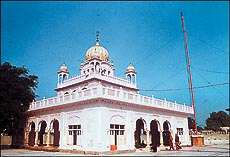 After the martyrdom of Guru Tegh Bahadur, Guru Gobind Singh began to plan his strategy at Gurdwara Fatehgarh Sahib. But before tackling the Mughal forces he had to reckon with Raja Bhim Chand of Bilaspur who had sent a force under Raja Kesari Chand to attack Anandpur Sahib. The Guru organised a battalion and ordered Bhai Uday Singh to get ready for battle. Bhai Uday Singh beheaded Kesari Chand and offered his head to the Guru. Guru Gobind Singh was very proud of his victorious army, so he built a fort at the spot and called it Fatehgarh Sahib.
After the martyrdom of Guru Tegh Bahadur, Guru Gobind Singh began to plan his strategy at Gurdwara Fatehgarh Sahib. But before tackling the Mughal forces he had to reckon with Raja Bhim Chand of Bilaspur who had sent a force under Raja Kesari Chand to attack Anandpur Sahib. The Guru organised a battalion and ordered Bhai Uday Singh to get ready for battle. Bhai Uday Singh beheaded Kesari Chand and offered his head to the Guru. Guru Gobind Singh was very proud of his victorious army, so he built a fort at the spot and called it Fatehgarh Sahib.

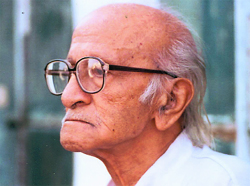
 Religion is supposed to spread love and peace, yet if we turn the pages of history, we find that religion is the cause of many of the wars and atrocities committed on humans by humans. In this age of international religious terrorism, most of us have begun to wonder what religion is, why is it so important for so many believers, why is one religion so intolerant of others, and do we need it after all?
Religion is supposed to spread love and peace, yet if we turn the pages of history, we find that religion is the cause of many of the wars and atrocities committed on humans by humans. In this age of international religious terrorism, most of us have begun to wonder what religion is, why is it so important for so many believers, why is one religion so intolerant of others, and do we need it after all?